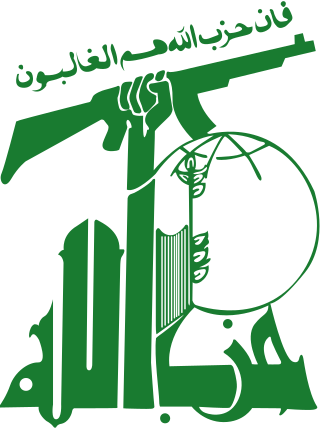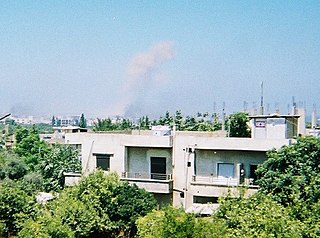| History of Lebanon |
|---|
 |
| Timeline |
This is a list of wars involving the Republic of Lebanon.
| History of Lebanon |
|---|
 |
| Timeline |
This is a list of wars involving the Republic of Lebanon.

Fatah, formally the Palestinian National Liberation Movement, is a Palestinian nationalist and social democratic political party. It is the largest faction of the confederated multi-party Palestine Liberation Organization (PLO) and the second-largest party in the Palestinian Legislative Council (PLC). Mahmoud Abbas, the President of the Palestinian Authority, is the chairman of Fatah.

Hezbollah is a Lebanese Shia Islamist political party and militant group, led since 1992 by its Secretary-General Hassan Nasrallah. Hezbollah's paramilitary wing is the Jihad Council, and its political wing is the Loyalty to the Resistance Bloc party in the Lebanese Parliament. Its armed strength is assessed to be equivalent to that of a medium-sized army.

The Israeli–Palestinian conflict is an ongoing military and political conflict about land and self-determination within the territory of the former Mandatory Palestine. Key aspects of the conflict include the Israeli occupation of the West Bank and Gaza Strip, the status of Jerusalem, Israeli settlements, borders, security, water rights, the permit regime, Palestinian freedom of movement, and the Palestinian right of return.

The Popular Front for the Liberation of Palestine – General Command or PFLP-GC is a Palestinian nationalist militant organisation based in Syria.

The Lebanese Civil War was a multifaceted armed conflict that took place from 1975 to 1990. It resulted in an estimated 150,000 fatalities and also led to the exodus of almost one million people from Lebanon.

Hassan Nasrallah is a Lebanese cleric and the secretary-general of Hezbollah, a Shia Islamist political party and militant group.
The Israeli–Lebanese conflict, or the South Lebanon conflict, is a series of military clashes involving Israel, Lebanon and Syria, the Palestine Liberation Organization, as well as various militias and militants acting from within Lebanon. The conflict peaked in the 1980s, during the Lebanese Civil War, and has abated since.

The South Lebanon conflict, designated by Israel as the Security Zone in Lebanon Campaign, was a protracted armed conflict that took place in southern Lebanon from 1985 to 2000. It saw fighting between Israel and the Catholic Christian-dominated South Lebanon Army (SLA) against Hezbollah-led Shia Muslim and left-wing guerrillas within the Israeli-occupied "Security Zone"; the SLA had military and logistical support from the Israel Defense Forces over the course of the conflict and operated under the jurisdiction of the Israeli-backed South Lebanon provisional administration, which succeeded the earlier Israeli-backed State of Free Lebanon. It can also refer to the continuation of the earlier conflict in this region involving the growing Palestinian insurgency in South Lebanon against Israel following the expulsion of the Palestine Liberation Organization (PLO) from Jordan after Black September. Historical tensions between Palestinian refugees and Lebanese factions contributed another layer to the Lebanese Civil War (1975–1990), which saw the Maronite-led Lebanese Front and the Shia Amal Movement at war with the PLO. Hence, the South Lebanon conflict can partly be seen as an extension of the civil war that ended in 1990.

The 2006 Lebanon War, also called the 2006 Israel–Hezbollah War and known in Lebanon as the July War and in Israel as the Second Lebanon War, was a 34-day military conflict in Lebanon, northern Israel and the Golan Heights. The principal parties were Hezbollah paramilitary forces and the Israel Defense Forces (IDF). The conflict started on 12 July 2006, and continued until a United Nations-brokered ceasefire went into effect in the morning on 14 August 2006, though it formally ended on 8 September 2006 when Israel lifted its naval blockade of Lebanon. Due to unprecedented Iranian military support to Hezbollah before and during the war, some consider it the first round of the Iran–Israel proxy conflict, rather than a continuation of the Arab–Israeli conflict.

The Arab–Israeli conflict is the phenomenon involving political tension, military conflicts, and other disputes between various Arab countries and Israel, which escalated during the 20th century. The roots of the Arab–Israeli conflict have been attributed to the support by Arab League member countries for the Palestinians, a fellow League member, in the ongoing Israeli–Palestinian conflict; this in turn has been attributed to the simultaneous rise of Zionism and Arab nationalism towards the end of the 19th century, though the two national movements had not clashed until the 1920s.

The 2007 Lebanon conflict began when fighting broke out between Fatah al-Islam, an Islamist militant organization, and the Lebanese Armed Forces (LAF) on May 20, 2007 in Nahr al-Bared, a UNRWA Palestinian refugee camp near Tripoli.
Casualties suffered by Palestinians in war:

The Bab al-Tabbaneh–Jabal Mohsen conflict was a recurring conflict between the Sunni Muslim residents of the Bab-al-Tabbaneh neighbourhood and the Alawite residents of the Jabal Mohsen neighbourhood of Tripoli, Lebanon from 1976 through 2015. Residents of the two neighbourhoods became rivals during the Lebanese Civil War and frequently engaged in violence. Residents were divided along sectarian lines and by their opposition to or support of the Alawite-led Syrian government. Violence flared up during the Syrian Civil War spillover in Lebanon.

The Palestinian insurgency in South Lebanon was a multi-sided armed conflict initiated by Palestinian militants against Israel in 1968 and against Lebanese Christian militias in the mid-1970s. It served as a major catalyst for the outbreak of the Lebanese Civil War in 1975. Fighting between the Palestinians and the Christian militias lasted until the Israeli invasion of Lebanon in 1982, which led to the expulsion of the Palestine Liberation Organization (PLO) from Lebanese territory. While the PLO relocated to Tunisia in the aftermath of Israel's invasion, other Palestinian militant factions, such as the Syria-based PFLP–GC, continued to carry out low-level operations from Syrian-occupied Lebanon. After 1982, the insurgency is considered to have faded in light of the inter-Lebanese Mountain War and the Israel–Hezbollah conflict, the latter of which took place for the duration of the Israeli occupation of South Lebanon.
The Battle of Yarmouk Camp was a period of fierce clashes in Yarmouk Camp during the Syrian civil war. Yarmouk is a district of Damascus that is home to the biggest community of Palestinian refugees in Syria. The fighting was between the Syrian Army and PFLP-GC on one side, and Syrian rebels on the other. The rebels included the Free Syrian Army (FSA) and a group made up of Palestinians, called Liwa al-Asifa or Storm Brigade. On 17 December, it was reported that the FSA and anti-Assad Palestinians had taken control of the camp. The FSA and Syrian Army agreed to leave Yarmouk as a neutral, demilitarized zone, but sporadic clashes continued.

The Iran–Israel proxy conflict, also known as the Iran–Israel proxy war or Iran–Israel Cold War, is an ongoing proxy conflict between Iran and Israel. In the Israeli–Lebanese conflict, Iran has supported Lebanese Shia militias, most notably Hezbollah. In the Israeli-Palestinian conflict, Iran has backed Palestinian groups such as Hamas. Israel has supported Iranian rebels, such as the People's Mujahedin of Iran, conducted airstrikes against Iranian allies in Syria and assassinated Iranian nuclear scientists. In 2018 Israeli forces directly attacked Iranian forces in Syria.

Following the outbreak of the protests of Syrian revolution during the Arab Spring in 2011 and the escalation of the ensuing conflict into a full-scale civil war by mid-2012, the Syrian Civil War became a theatre of proxy warfare between various regional powers such as Turkey and Iran. Spillover of the Syrian civil war into the wider region began when the Iraqi insurgent group known as the Islamic State of Iraq (ISI) started intervening in the conflict from 2012.
Khalil al-Hayya is a senior Hamas official who was elected to the Palestinian Legislative Council on 25 January 2006 as a representative of Gaza City. He resided in the neighborhood of Shuja'iyya.

Hezbollah involvement in the Syrian Civil War has been substantial since the beginning of armed insurgency phase of the Syrian Civil War in 2011, and evolved into active support for Ba'athist government forces and troop deployment from 2012 onwards. By 2014, Hezbollah was deployed across Syria. Hezbollah has also been very active in preventing Al-Nusra Front and Islamic State penetration into Lebanon, being one of the most active forces in the Syrian Civil War spillover in Lebanon.